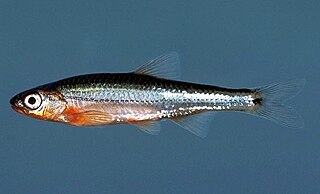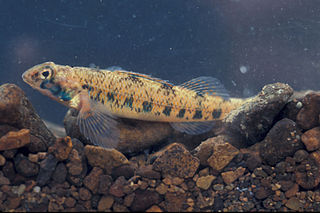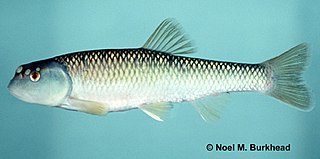
The Tennessee shiner is a species of fish in the family Cyprinidae, the carps and minnows. It is native to the southeastern United States.

The Sonora chub is a species of ray-finned fish in the family Cyprinidae. It is found in Mexico and the United States.
The ashy darter is a species of freshwater ray-finned fish, a darter from the subfamily Etheostomatinae, part of the family Percidae, which also contains the perches, ruffes and pikeperches. It is endemic to the eastern United States.
The Caddo madtom is a species of fish in the family Ictaluridae endemic to the United States. N. taylori was named in honor of William Ralph Taylor, U.S. National Museum, in recognition of his contributions to the knowledge of catfishes. They average 2 to 4 inches long and weigh no more than a few ounces. N. taylori has a small to tiny, fragmented range, but is mostly found in the Caddo, Ouachita, and Little Missouri Rivers in southwestern Arkansas. Ecological studies indicate that dam and bridge construction poses barriers to dispersal and migration of fish in the Ouachita Highlands. IUCNredlist.org states that better information is needed on life history, reproductive biology, and ecology of the Caddo madtom. This species is listed as endangered on the IUCN Red List. Limited range makes this species vulnerable to habitat destruction/degradation from impoundment, pollution, and other factors. Robison and Buchanan (1988) stated, "this rare species should be considered threatened due to loss of habitat". Warren et al. (2000) categorized the species as "threatened".

The rainbow shiner is a North American species of ray-finned fish in the genus Notropis.

The ghost shiner is a North American species of freshwater fish of the family Cyprinidae. It is generally characterized as being a small bodied, silvery and fusiform shaped cyprinid. Notropis buchanani is morphologically similar to and often mistaken for the Mimic Shiner, which is evident by its former classification as a subspecies of Notropis volucellus.
The plains minnow is one of the 324 fish species found in central United States. It is a large minnow that was once a common bait fish. The plains minnow requires shallow, slow-moving streams to complete its life cycle. Pollution, dams, and introduced sport fish have caused populations to decline.

The warpaint shiner is a species of freshwater fish found in North America. It is common in the upper Tennessee River basin as well as in the Savannah River, the Santee River, and the New River in North Carolina. Adults have a mean length of 9 centimetres (3.5 in) and can reach a maximum length of 14 centimetres (5.5 in). The maximum age reported for this species is 4 years.
The redtail chub is a freshwater fish found in the U.S. states of Tennessee and Kentucky.
The river chub is a minnow in the family Cyprinidae. It is one of the most common fishes in North American streams.

The chucky madtom is a critically endangered freshwater fish endemic to the U.S. state of Tennessee.
The Cumberland snubnose darter is a species of freshwater ray-finned fish, a darter from the subfamily Etheostomatinae, part of the family Percidae, which also contains the perches, ruffes and pikeperches. This species is found in the middle Cumberland River drainage in Tennessee, Kentucky, Virginia, North Carolina, Georgia, and Alabama. It is absent in reaches above the Big South Fork, rare in North Carolina, and absent in western tributaries of the Tennessee River. While research on the ecology of E. atripinne is not extensive, what is known is they are usually found in small to medium freshwater streams in gravel riffle areas where their eggs can attach to the substrate and be left unguarded. E. atripinne can be found within a wide range of depths in its environment, leading its being classified as benthopelagic. While its global status is secure, the American Fisheries Society labels it with a status of “Special Concern”.

The orangefin darter is a species of freshwater ray-finned fish, a darter from the subfamily Etheostomatinae, part of the family Percidae, which also contains the perches, ruffes and pikeperches. It is found in Barren River and Green River systems in Tennessee and Kentucky.
The golden darter is a species of freshwater ray-finned fish, a darter from the subfamily Etheostomatinae, part of the family Percidae, which also contains the perches, ruffes and pikeperches. It is found in the upper Tennessee River, one of the over 300 fish species found in Tennessee.

The blueside darter is usually found in the Tennessee River drainage in Tennessee, Alabama, North Carolina, and Virginia, and less commonly found in Bear Creek, Shoal Creek, and Barren Fork.
The goldstripe darter is a species of freshwater ray-finned fish, a darter from the subfamily Etheostomatinae, part of the family Percidae, which also contains the perches, ruffes and pikeperches. It is endemic to the southeastern United States where it is found in Gulf Slope streams from the Colorado River drainage in Texas to the Flint River in Georgia, the Atlantic Slope in Ocmulgee River system, Georgia, and the Mississippi embayment north as far as southeastern Missouri and western Kentucky. It is typically found in small springs, streams, and creeks with aquatic and marginal vegetation and detritus. The female spawns on multiple occasions between about mid-March and June, sticking the adhesive eggs to plants, gravel and the sides of rocks. The goldstripe darter is a common species with a wide range and numerous sub-populations, and the International Union for Conservation of Nature has assessed its conservation status as being of "least concern".

The blackbanded darter is a species of freshwater ray-finned fish, a darter from the subfamily Etheostomatinae, part of the family Percidae, which also contains the perches, ruffes and pikeperches. It is native to the river systems of the southeastern United States where it is found in the states of Tennessee, Georgia, Florida, Mississippi, Alabama, and Louisiana. It lives over sandy or gravelly bottoms in smaller rivers and streams and its color varies depending on the different habitats in which it lives. It feeds on small insect larvae and is itself preyed on by larger fish. It spawns between February and June depending on locality. It is generally a common fish throughout most of its range.
The saddleback darter is a species of freshwater ray-finned fish, a darter from the subfamily Etheostomatinae, part of the family Percidae, which also contains the perches, ruffes and pikeperches. It is native to the eastern United States. This darter species is widespread, occurring from the Escambia River drainage west to the Mississippi River basin and as far north as the Wabash River historically. Some populations have been reported in the Tennessee River drainage. The saddleback darter is aptly named as it has 5 saddle-like patterns on its dorsum, with the first occurring near the first dorsal fin and the fifth near the caudal penduncle. Adults can attain a maximum size of about 3 inches or 7.8 centimeters. The saddleback darter typically occurs over sand and gravel runs of creeks and small to medium-sized rivers and is sometimes found in very shallow water. This darter's diet consists of invertebrates such as caddisfly larvae, beetles, mayflies, and stoneflies. The saddleback darter deposits eggs over sand and gravel shoals during the spring. This species has an average lifespan between 2 and 3 years.
Spotfin chub is a ray-finned fish in the family Cyprinidae that is endemic to the Tennessee River watershed. Its other common names include turquoise shiner and chromium shiner.

The bluehead chub is a cyprinid native to North America. Its name is due to its appearance, as breeding males have a blue head. Adult bluehead chubs are, on average, between 70 and 160 mm in length. They have a robust body with uniformly large scales. The scales are present on the belly and breast. They have a pored body, a weakly falcate pectoral fin, and pharyngeal teeth. They have a large mouth, small eyes, and a terminal barbel. Other characteristics include a darkened lateral band, spot on the caudal fin, and red coloration of the fins and iris of the eyes. They have 40 lateral line scales and 8 anal rays. The bluehead chub is a freshwater fish, and lives in pools, rivers, and streams. They feed on insects and plants.












